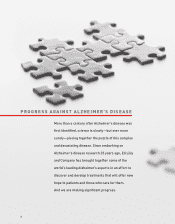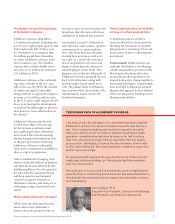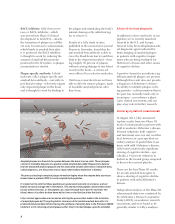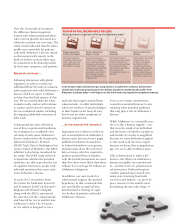Eli Lilly 2012 Annual Report Download - page 18
Download and view the complete annual report
Please find page 18 of the 2012 Eli Lilly annual report below. You can navigate through the pages in the report by either clicking on the pages listed below, or by using the keyword search tool below to find specific information within the annual report.
6
terminate the collaboration. Commercial operations were transferred to Amylin in the U.S. at the end
of November 2011. Outside the U.S., we anticipate transferring responsibility for commercialization of
exenatide to Amylin in substantially all markets by the end of the first quarter of 2013. See Item 8,
“Financial Statements and Supplementary Data—Note 4, Collaborations,” for more information on the
November 2011 agreement.
• Erbitux is marketed in North America by Bristol-Myers Squibb. We have the option to co-promote
Erbitux in North America. Outside North America, Erbitux is commercialized by Merck KGaA. We
receive royalties from Bristol-Myers Squibb and Merck KGaA.
• Effient is co-promoted with us by Daiichi Sankyo in the U.S., major European markets, Brazil, Mexico,
China, and certain other countries. We retain sole marketing rights in Canada, Australia, Russia, and
certain other countries. Daiichi Sankyo retains sole marketing rights in Japan and certain other
countries.
• Tradjenta and Jentadueto are being jointly developed and commercialized with us by Boehringer
Ingelheim pursuant to a collaboration agreement reached in 2011 under which both parties
contributed certain mid- and late-stage development potential diabetes treatments to be jointly
developed and commercialized by the parties.
Animal Health Products
Our Elanco animal health business unit employs field salespeople throughout the U.S. and has an extensive
sales force outside the U.S. Elanco sells its products primarily to wholesale distributors. Elanco promotes its
products primarily to producers and veterinarians for food animal products and to veterinarians for
companion animal products. Elanco also advertises certain companion animal products directly to pet
owners.
Competition
Our human pharmaceutical products compete globally with products of many other companies in highly
competitive markets. Our animal health products compete globally with products of animal health care
companies as well as pharmaceutical, chemical, and other companies that operate animal health businesses.
Important competitive factors include safety, effectiveness, and ease of use of our products; price and
demonstrated cost-effectiveness; marketing effectiveness; and research and development of new products
and processes. Most new products that we introduce must compete with other products already on the market
or products that are later developed by competitors. If competitors introduce new products or delivery
systems with therapeutic or cost advantages, our products can be subject to progressive price reductions,
decreased sales volume, or both. Increasingly, to obtain favorable reimbursement and formulary positioning
with government payers, managed care organizations, and pharmacy benefits managers, we must
demonstrate that our human pharmaceuticals offer not only medical benefits but also more value as
compared with other forms of care.
Manufacturers of generic pharmaceuticals invest far less than we do in research and development and
typically have lower manufacturing cost structures; therefore, they can price their products much lower than
our branded products. Accordingly, when our branded pharmaceutical loses its market exclusivity, it normally
faces intense price competition from generic forms of the product. In many countries outside the U.S.,
intellectual property protection is weak and we must compete with generic or counterfeit versions of our
products. Many of our animal health products also compete with generics.
We believe our long-term competitive success depends upon discovering and developing (either alone or in
collaboration with others) or acquiring innovative, cost-effective human pharmaceuticals and animal health
products that provide improved outcomes and deliver value to payers, together with our ability to continuously
improve the productivity of our operations in a highly competitive environment. There can be no assurance
that our research and development efforts will result in commercially successful products, and it is possible
that our products will become uncompetitive from time to time as a result of products developed by our
competitors.
























